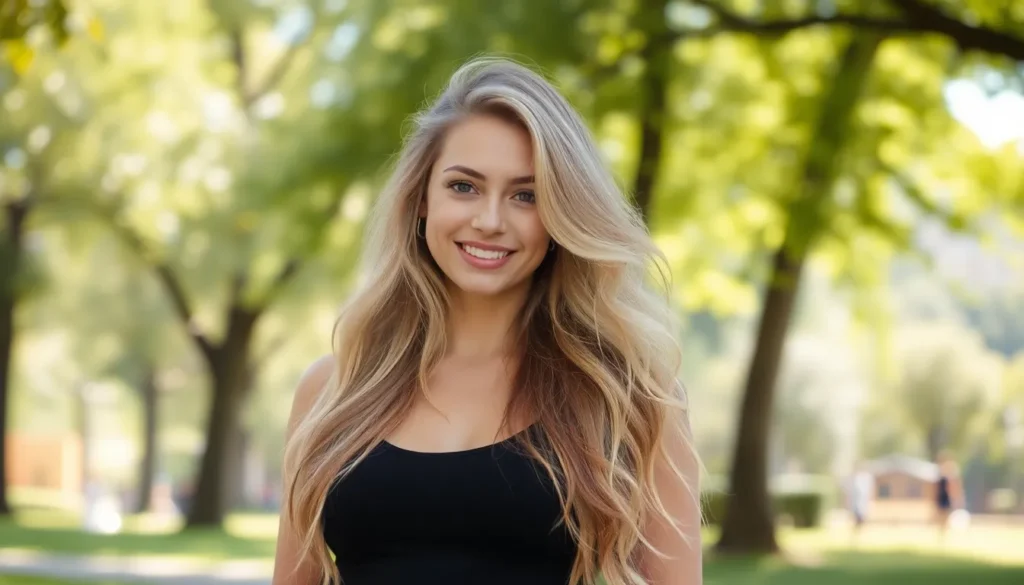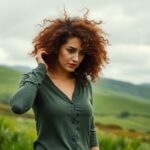Remember when Farrah Fawcett’s iconic hairstyle had everyone rushing to their stylists in the 1970s? Feathered hair became the defining look of an entire decade and it’s making a stunning comeback in today’s fashion industry. This voluminous layered style creates movement and texture that flatters virtually every face shape.
We’ve watched this timeless trend evolve from its disco-era origins to modern interpretations that celebrities and influencers are sporting on red carpets and social media. The feathered cut’s signature swept-back layers create an effortlessly glamorous look that adds instant sophistication to any style.
Whether you’re considering a dramatic hair transformation or simply want to understand why this retro style continues to captivate new generations we’ll guide you through everything you need to know about feathered hair. From styling techniques to maintenance tips this classic cut might just be the perfect way to refresh your look.
What Is Feathered Hair and Why It’s Making a Comeback
Feathered hair represents one of the most enduring hairstyles that continues to captivate modern audiences with its timeless appeal.
Definition and Key Characteristics
Feathered hair creates volume and movement through strategically placed layers that flip away from the face. The technique involves cutting hair at different lengths to achieve a soft, flowing appearance that resembles bird feathers. Stylists use a combination of layering and texturizing methods to build the signature voluminous shape.
Volume becomes the defining feature of authentic feathered cuts. Hair appears fuller and more ever-changing through expert layering that adds dimension from roots to ends. Professional colorists often enhance the effect with highlights or lowlights that accentuate each individual layer.
Movement characterizes every strand in properly executed feathered styles. Each layer flows seamlessly into the next, creating natural bounce and swing with every head turn. The cut works particularly well with medium to thick hair textures that hold the layered shape throughout the day.
Face framing elements distinguish quality feathered haircuts from basic layered styles. Strategic placement of shorter layers around the face creates flattering angles that soften harsh features. These carefully positioned pieces work to highlight cheekbones and create visual balance.
The Modern Revival of This Classic Style
Social media platforms have reignited interest in feathered hair among younger generations. Instagram and TikTok feature countless tutorials showcasing updated versions of the classic cut. Beauty influencers regularly demonstrate how to achieve the perfect feathered look using contemporary styling tools and products.
Celebrity endorsements continue driving the feathered hair comeback across red carpets and fashion events. Stars like Scarlett Johansson, Blake Lively, and Jennifer Aniston have embraced modern interpretations of the style. Their high profile appearances generate millions of social media impressions and salon appointment requests worldwide.
Styling technology advances make feathered hair more accessible than ever before. Round brushes with ceramic barrels create smoother results with less heat damage than vintage tools. Modern volumizing mousses and texturizing sprays help maintain the signature bounce without stiffness or crunchiness.
Customization options allow individuals to adapt feathered cuts to their unique features and lifestyle needs. Shorter versions work perfectly for busy professionals who need quick morning routines. Longer feathered styles suit those who prefer more dramatic transformations and versatile styling possibilities.
How Feathered Hair Became an Iconic 1970s Trend
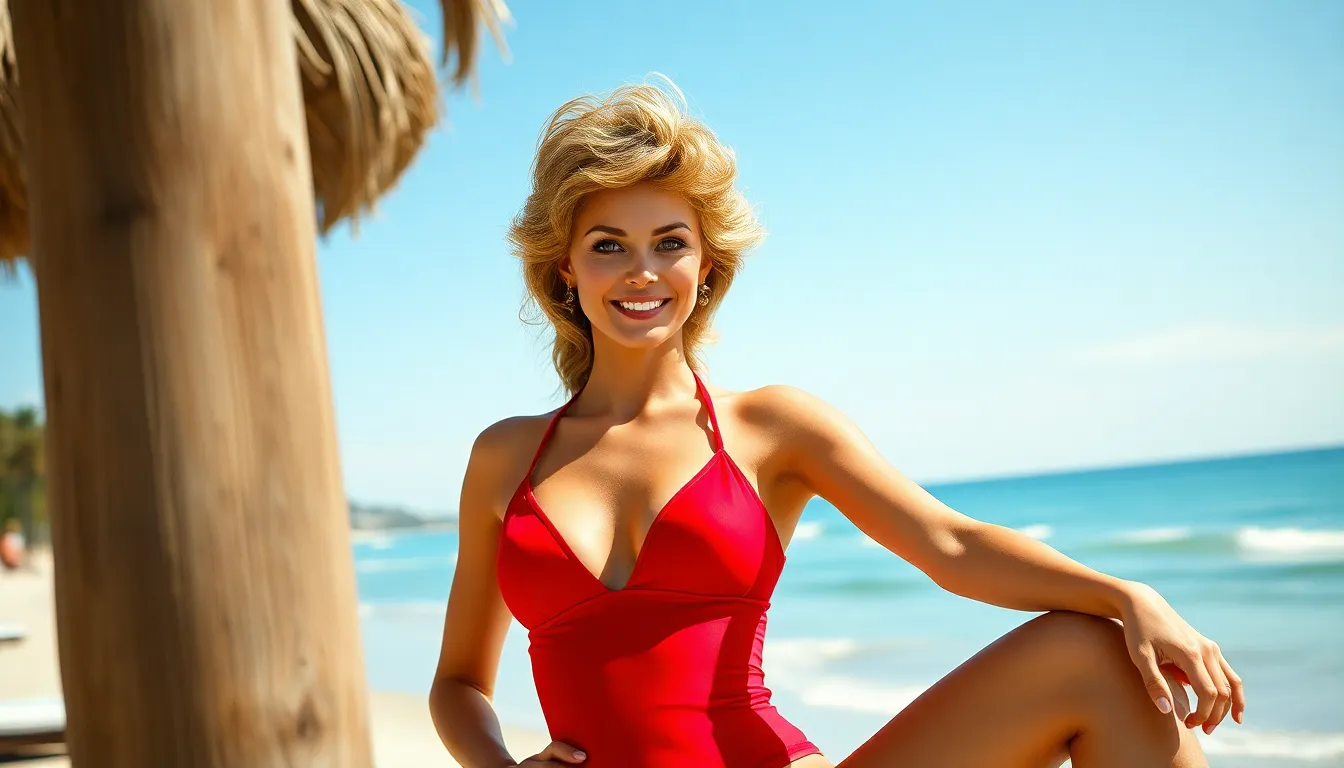
The feathered hair phenomenon didn’t emerge overnight but became a cultural sensation through strategic celebrity influence and perfect timing with the decade’s fashion movements.
Celebrity Influences and Pop Culture Impact
Television played the primary role in launching feathered hair into mainstream consciousness during the mid-1970s. Stars like Dorothy Hamill showcased the style’s versatility through her Olympic performances, demonstrating how feathered cuts could maintain their shape during athletic activities. Fashion magazines began featuring the layered look on their covers, with models displaying various interpretations of the feathered technique.
Musicians embraced the trend enthusiastically, with rock stars and disco artists incorporating feathered styles into their stage personas. Bands like Fleetwood Mac popularized longer feathered variations that complemented the era’s bohemian aesthetic. Female vocalists particularly gravitated toward the style because it photographed beautifully under stage lights and maintained volume throughout lengthy performances.
Hollywood amplified the trend’s reach through major motion pictures and television appearances. Actresses found that feathered hair translated exceptionally well to both close-up shots and wide-angle scenes. The style’s movement and dimension created visual interest on screen while remaining professionally polished for daytime television appearances.
The Connection to Farrah Fawcett’s Legendary Look
Farrah Fawcett’s portrayal of Jill Munroe in “Charlie’s Angels” transformed feathered hair from a trendy style into a cultural phenomenon in 1976. Her signature look featured perfectly symmetrical layers that flipped away from her face, creating the quintessential feathered silhouette that millions would attempt to recreate. Hairstylist Allen Edwards crafted Fawcett’s iconic cut using precise layering techniques that emphasized volume at the crown while maintaining sleek ends.
The famous red swimsuit poster featuring Fawcett’s feathered hair became one of the best-selling posters of all time, selling over 12 million copies worldwide. Salons across America reported unprecedented demand for “the Farrah,” with stylists struggling to meet client expectations for the complex layering required. Beauty supply stores experienced shortages of round brushes and volumizing products as consumers attempted to achieve the look at home.
Fawcett’s natural hair texture proved ideal for the feathered style, but her hairstylist revealed that achieving the perfect flip required daily styling with hot rollers and professional-grade products. The maintenance demands of her signature look actually contributed to the trend’s evolution, as stylists began adapting the technique for different hair types and lifestyles. Her influence extended beyond the initial “Charlie’s Angels” era, with beauty professionals continuing to reference her iconic cut when creating modern feathered variations.
Essential Tools and Products for Creating Feathered Hair
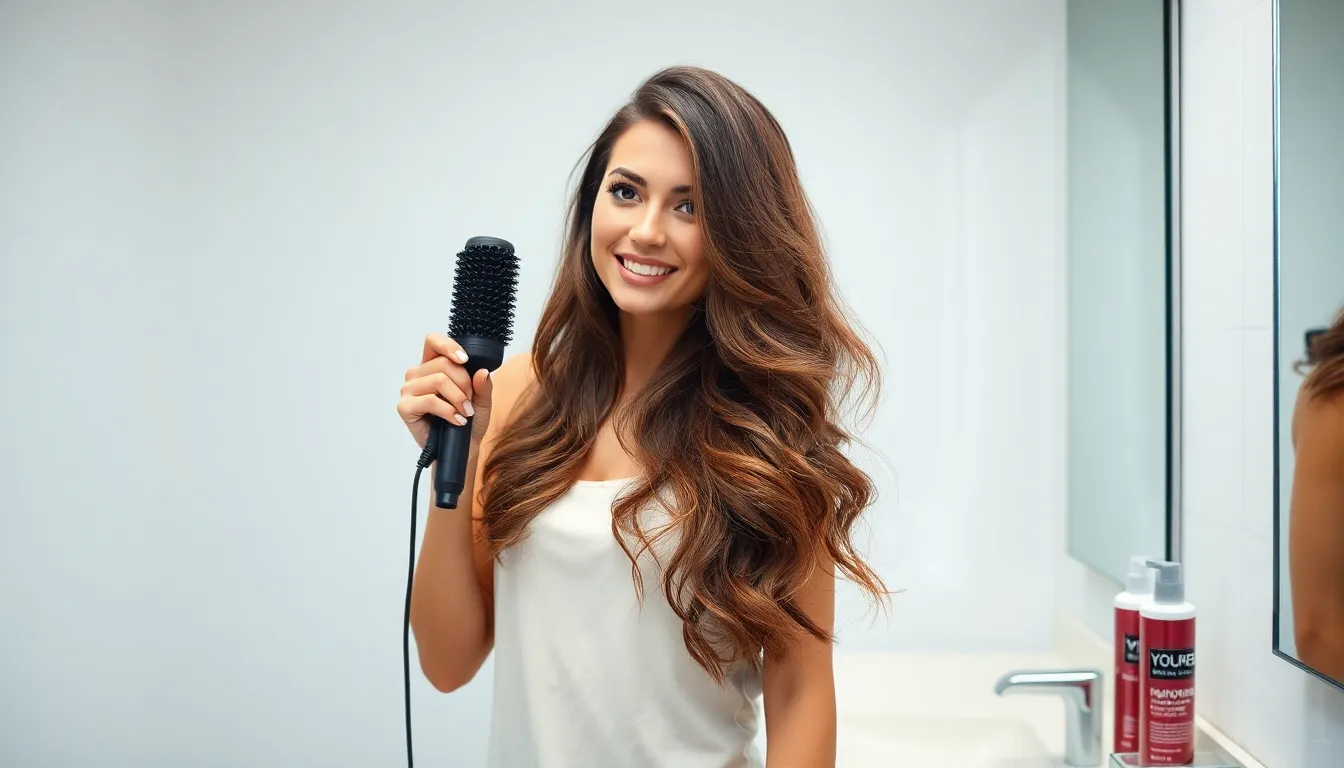
Achieving the perfect feathered hair look requires exact tools and styling products that work together to create volume, movement, and that signature flipped-away-from-the-face effect. We’ll explore the must-have equipment and products that make recreating this iconic style possible at home.
Round Brushes and Blow Dryers
Round brushes serve as the foundation for creating authentic feathered hair volume and shape. We recommend using a large barrel round brush with natural boar bristles, as these grip the hair effectively while distributing natural oils for added shine. The brush should measure between 2 to 3 inches in diameter to accommodate the sweeping motions required for proper feathering technique.
Professional-grade blow dryers with multiple heat and speed settings provide the control needed for precise styling. We suggest investing in a dryer with at least 1800 watts of power and ionic technology to reduce frizz while improving shine. The concentrator nozzle attachment becomes essential for directing airflow exactly where you need it during the styling process.
Sectioning clips help divide hair into manageable portions while styling each layer. We use these clips to separate the top layers from the bottom sections, ensuring each part receives adequate attention during the blow-drying process. This systematic approach prevents tangling and creates more uniform results throughout the entire head.
Styling Products for Volume and Hold
Volumizing mousses applied to damp hair before blow-drying create the lift and body essential for feathered styles. We apply these lightweight foams from roots to mid-length, focusing on areas where maximum volume is desired. The best mousses contain polymers that expand when heated, providing lasting fullness without weighing hair down.
Heat protectant sprays shield hair from thermal damage during styling while adding subtle texture. We mist these products evenly throughout damp hair before using any heated tools, ensuring comprehensive protection from root to tip. Quality heat protectants also contain conditioning agents that maintain hair health during frequent styling.
Flexible hold hairsprays lock in the feathered shape without creating stiffness or crunch. We finish each styling session with a light mist of hairspray held 8 to 10 inches away from the hair. The ideal spray provides movement while maintaining the carefully crafted layers and flipped ends that define the feathered look.
Texturizing creams enhance the natural movement of feathered cuts when applied sparingly to dry hair. We work small amounts of these products through the mid-lengths and ends to accentuate the layered structure and add definition to individual pieces.
Step-by-Step Guide to Achieving Perfect Feathered Hair
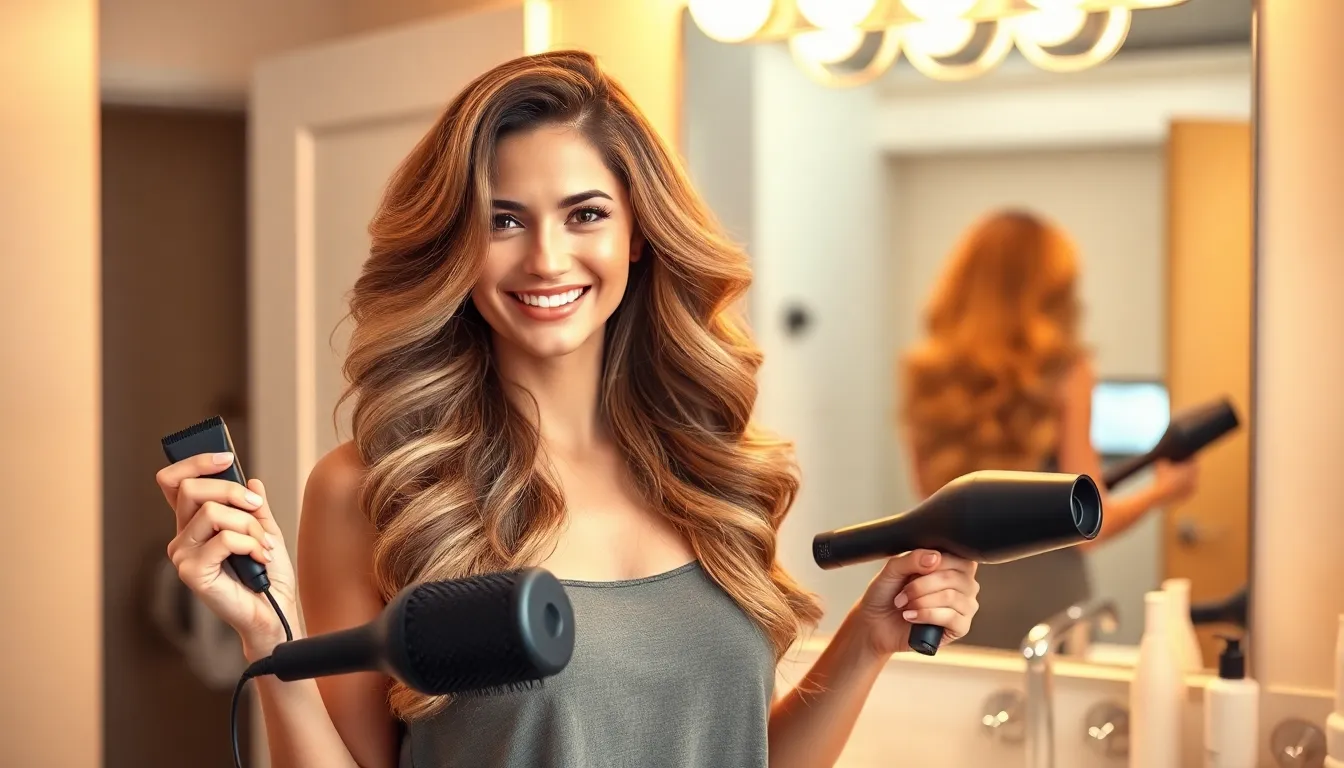
Creating that iconic feathered look requires mastering exact techniques that build upon each other. We’ll walk you through each essential step to recreate this timeless style at home.
Preparation and Hair Washing Techniques
Start with freshly washed hair using a volumizing shampoo that lifts roots without weighing down strands. Concentrate the shampoo on your scalp rather than the lengths to prevent dryness while maximizing lift at the crown.
Apply volumizing conditioner from mid-length to ends only. This placement prevents roots from becoming flat while maintaining necessary moisture in areas that receive the most heat styling. Leave the conditioner on for 2-3 minutes before rinsing thoroughly with cool water to seal the hair cuticle.
Gently squeeze excess water from your hair using a microfiber towel. Avoid aggressive rubbing that can create frizz and disrupt the hair’s natural texture. Pat sections starting from the crown and working toward the ends to maintain smooth cuticles.
Apply a volumizing mousse to damp hair, focusing on roots and mid-lengths. Use approximately a golf ball sized amount for medium length hair, distributing it evenly with your fingers. This product creates the foundation for lasting volume that won’t collapse during styling.
Blow Drying Methods for Maximum Volume
Section your hair into three horizontal layers using sectioning clips. Start with the bottom section while keeping upper layers secured. This systematic approach ensures even heat distribution and prevents missed spots that could result in flat areas.
Use a round boar bristle brush to lift each section away from your scalp while blow drying. Place the brush under a 2-inch section at the roots, then pull upward and slightly back as you direct hot air from the blow dryer down the hair shaft. This technique creates the signature lift that defines feathered cuts.
Roll the brush away from your face at the ends of each section. This motion establishes the outward flip that characterizes authentic feathered hair. Hold the position for 5-10 seconds with cool air to set the shape before releasing.
Focus extra attention on the layers around your face. These pieces frame your features and require the most dramatic outward movement. Use a smaller round brush for better control when styling these shorter sections.
Complete each section before moving to the next layer. This methodical approach prevents sections from falling flat while you work on other areas. The heat and tension must be consistent throughout the entire styling process.
Styling and Finishing Touches
Apply a light texturizing cream to the ends of your feathered layers. This product enhances separation between pieces while adding subtle definition that prevents the style from looking too uniform. Work it through with your fingertips for natural movement.
Use a flexible hold hairspray to lock in the volume and shape. Spray from 8-10 inches away, focusing on the roots and the curved ends of your layers. This distance prevents product buildup while providing lasting hold.
Gently tease the crown area with a fine tooth comb for extra height. Lift small sections straight up and lightly backcomb toward the scalp. This creates additional volume that enhances the overall feathered silhouette.
Finish with a light misting of shine spray on the mid-lengths and ends. This final step adds luminous dimension that catches light beautifully and enhances the healthy appearance of your feathered cut. Avoid applying shine products to roots to maintain volume.
Set the entire style with a final blast of cool air from your blow dryer. This technique seals the hair cuticle and helps your feathered look maintain its shape throughout the day.
Modern Variations of Feathered Hair for Today’s Look
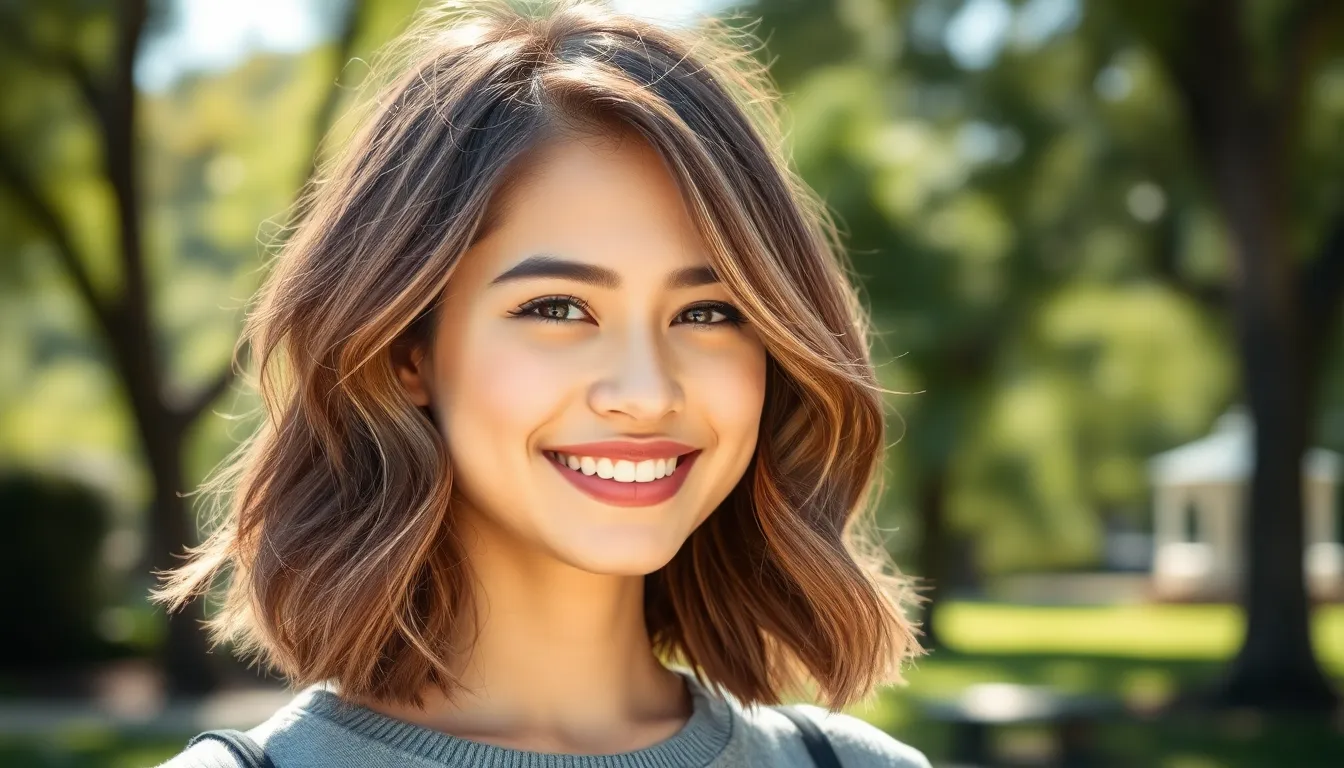
Today’s feathered hairstyles blend classic volume techniques with contemporary cutting methods. We’ve seen hairstylists adapt the iconic 1970s trend to suit modern preferences and lifestyle demands.
Short Feathered Hair Styles
Short feathered cuts offer effortless sophistication for busy lifestyles while maintaining the signature flip that defines this classic style. We recommend pixie feathered cuts that feature longer layers around the crown and temples, creating natural movement without excessive maintenance. Asymmetrical feathered bobs work particularly well for square and round face shapes, with layers starting just below the ears to frame facial features beautifully.
Textured feathered crops provide edgy alternatives to traditional longer versions, using choppy layers that flip outward at the nape and sides. We’ve noticed that chin length feathered cuts with side swept bangs create youthful appearances while offering professional polish for workplace environments. Graduated feathered styles transition smoothly from shorter back sections to longer front pieces, delivering versatility for styling in multiple directions.
Long Feathered Hair Adaptations
Long feathered hairstyles showcase dramatic volume and movement through extended layering techniques that maintain hair health. We suggest curtain bang feathered cuts that blend seamlessly with shoulder length layers, creating soft frames around the face while preserving length. Layered feathered styles with subtle highlights enhance dimension and emphasize the natural flip pattern characteristic of authentic feathered hair.
Beach wave feathered adaptations combine loose texturing with strategic layering to achieve effortless movement that works for casual and formal occasions. We recommend graduated long feathered cuts that start layering at the collarbone, allowing maximum versatility for updos and styling variations. Blended feathered layers in long hair require professional cutting to ensure smooth transitions and prevent choppy appearances that can diminish the style’s elegance.
Face-Framing Feathered Layers
Face framing feathered layers target exact areas around the hairline to enhance natural features and create flattering silhouettes. We focus on temple feathered sections that flip away from the face, softening angular jawlines and highlighting cheekbones effectively. Graduated layers around the ears provide natural lift while maintaining the signature outward movement that defines authentic feathered styling.
Customized feathered face frames adapt to individual bone structure, with shorter layers for heart shaped faces and longer pieces for oval facial types. We recommend strategic feathering that starts at eye level, creating gentle movement that draws attention to the eyes while maintaining overall hair volume. Precision cut face framing layers require regular maintenance every 6 to 8 weeks to preserve their shape and ensure continued styling success.
Best Hair Types and Face Shapes for Feathered Hair
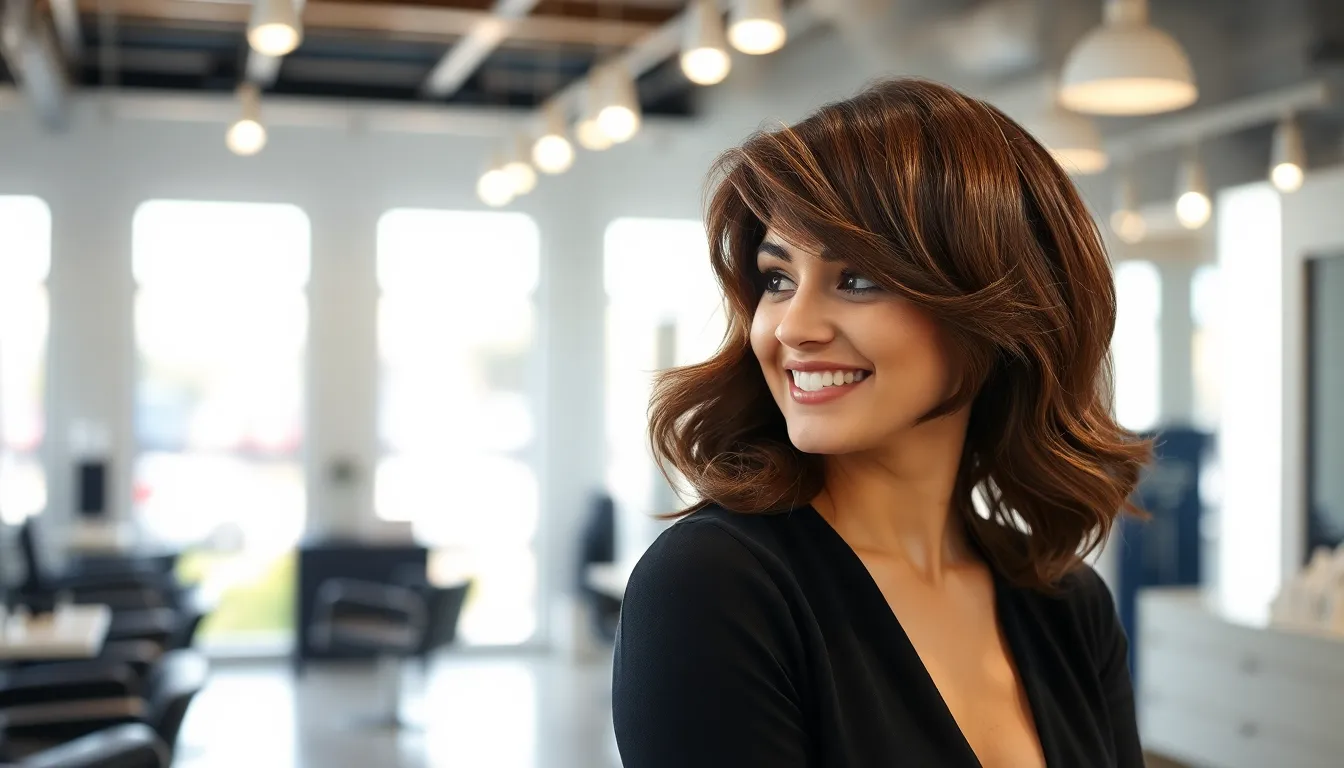
We’ve discovered that choosing the right feathered hairstyle depends heavily on your natural hair texture and face shape. Understanding these compatibility factors ensures your feathered cut enhances your best features.
Ideal Hair Textures and Lengths
Medium to thick hair textures work exceptionally well with feathered cuts because they provide the necessary volume foundation. Natural density allows layers to maintain their signature bounce without falling flat throughout the day. Coarse hair holds feathered shapes beautifully since the texture creates natural lift at the roots.
Fine hair can achieve stunning feathered results with proper layering techniques and volumizing products. Strategic cutting creates the illusion of thickness while maintaining manageable weight distribution. Texturizing creams and root lifting sprays become essential tools for fine haired individuals pursuing this classic style.
Shoulder length to long hair offers the most versatility for feathered styling options. Extended lengths provide ample canvas for dramatic layering effects and sophisticated movement patterns. Medium length cuts between chin and shoulder create balanced proportions while shorter lengths require more frequent maintenance visits.
Wavy and naturally textured hair enhances feathered cuts with effortless movement and organic volume. Natural curl patterns complement the layered structure without requiring extensive heat styling routines. Straight hair achieves feathered looks through skilled blow drying techniques and quality round brush manipulation.
Complementary Face Shapes
Oval face shapes benefit most from feathered hairstyles since the layered volume balances natural proportions perfectly. Side swept feathered bangs enhance cheekbone definition while maintaining elegant facial framing. Length variations work universally well with oval features from pixie cuts to long layered styles.
Round faces gain flattering definition through strategically placed feathered layers that create vertical lines. Height at the crown elongates facial appearance while side parted styles add asymmetrical interest. Avoiding excessive volume at the sides prevents unwanted width emphasis in the cheek area.
Square jaw lines soften beautifully with feathered cuts that curve around facial angles. Layered movement creates gentle transitions that complement strong bone structure without overwhelming delicate features. Chin length feathered bobs provide ideal proportional balance for angular face shapes.
Heart shaped faces pair wonderfully with feathered styles that add width at the jawline level. Lower layer placement balances narrower chin areas while managing broader forehead proportions. Feathered bangs can minimize forehead width when styled with proper sweep techniques.
Long face shapes benefit from horizontal volume created through feathered layer placement at cheek level. Width improving techniques include side swept styling and curved layer patterns that break up vertical lines. Avoiding excessive height at the crown prevents further facial elongation.
Maintenance Tips for Keeping Your Feathered Hair Looking Fresh
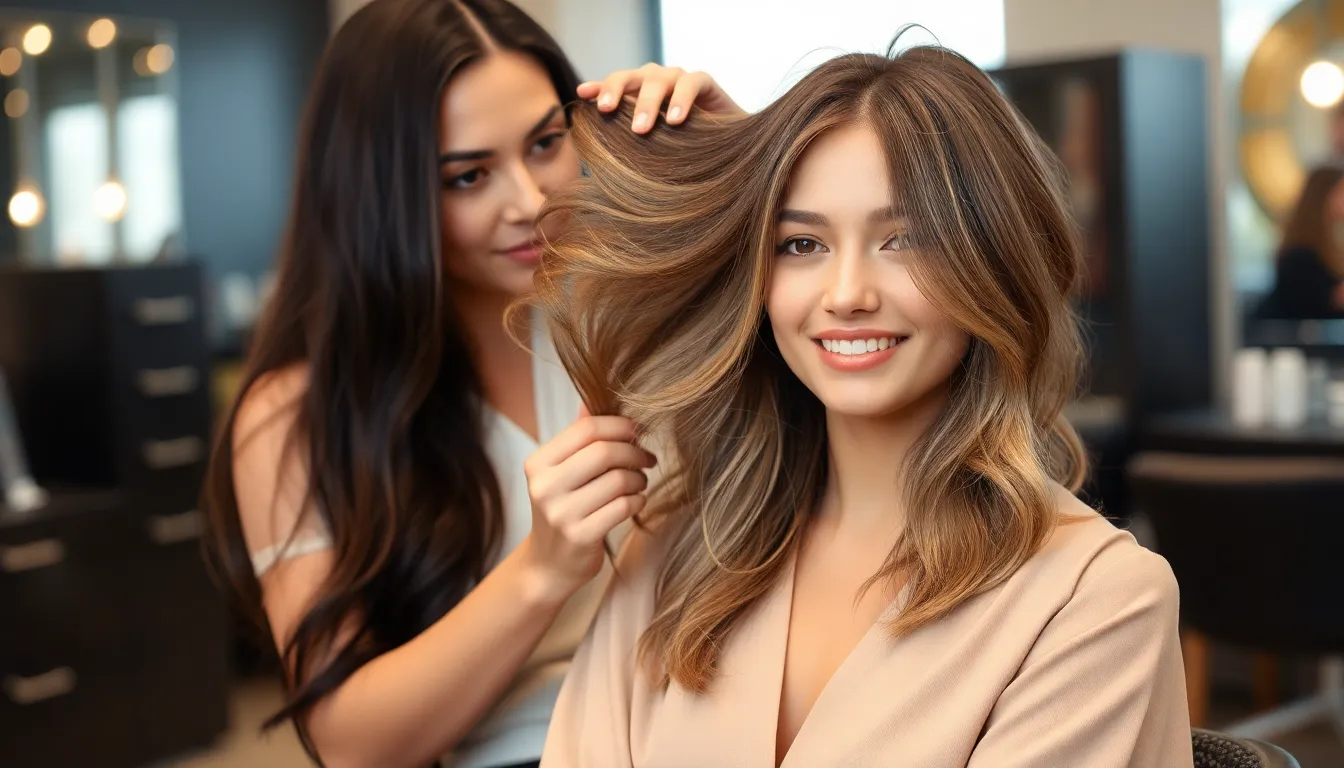
Maintaining your feathered hair requires consistent care and attention to detail. We’ll share the essential strategies that keep your layers looking voluminous and healthy.
Daily Styling Routine
Start each morning by refreshing your feathered layers with a light mist of water or leave-in conditioner. This reactivates the natural movement and bounce that defines authentic feathered cuts.
Apply a small amount of volumizing mousse to damp roots, focusing on the crown area where lift is most crucial. We recommend working the product through with your fingers to avoid weighing down the delicate layers.
Use your round brush with natural boar bristles during blow drying, directing each section away from your face in smooth, sweeping motions. The key is maintaining consistent tension while wrapping hair around the barrel to create that signature outward flip.
Finish with a flexible hold hairspray, misting each layer individually rather than coating the entire head. This technique preserves the natural movement while providing structure throughout the day.
Touch up any flattened sections with a small barrel curling iron, rolling pieces away from your face for 10-15 seconds. Quick refresh techniques like these maintain your style’s integrity between full styling sessions.
Regular Trim Schedule
Schedule professional trims every 6-8 weeks to maintain the precise layering that creates feathered hair’s distinctive shape. Regular cuts prevent the layers from growing out unevenly and losing their defined structure.
Book appointments specifically with stylists experienced in layered cuts, as feathered hair requires technical precision in layer placement. We suggest bringing reference photos of your desired shape to each appointment.
Maintain the shortest layers around your face every 4-5 weeks with mini trim sessions. These face framing pieces grow fastest and directly impact how polished your feathered style appears.
Monitor your hair’s growth patterns between appointments, noting which sections lose their shape first. Most clients find that crown layers and side pieces need the most frequent attention to preserve volume.
Communicate with your stylist about any changes in your hair’s texture or thickness, as these factors influence how often you’ll need maintenance cuts. Environmental factors like humidity and seasonal changes also affect your trim schedule requirements.
Common Mistakes to Avoid When Styling Feathered Hair
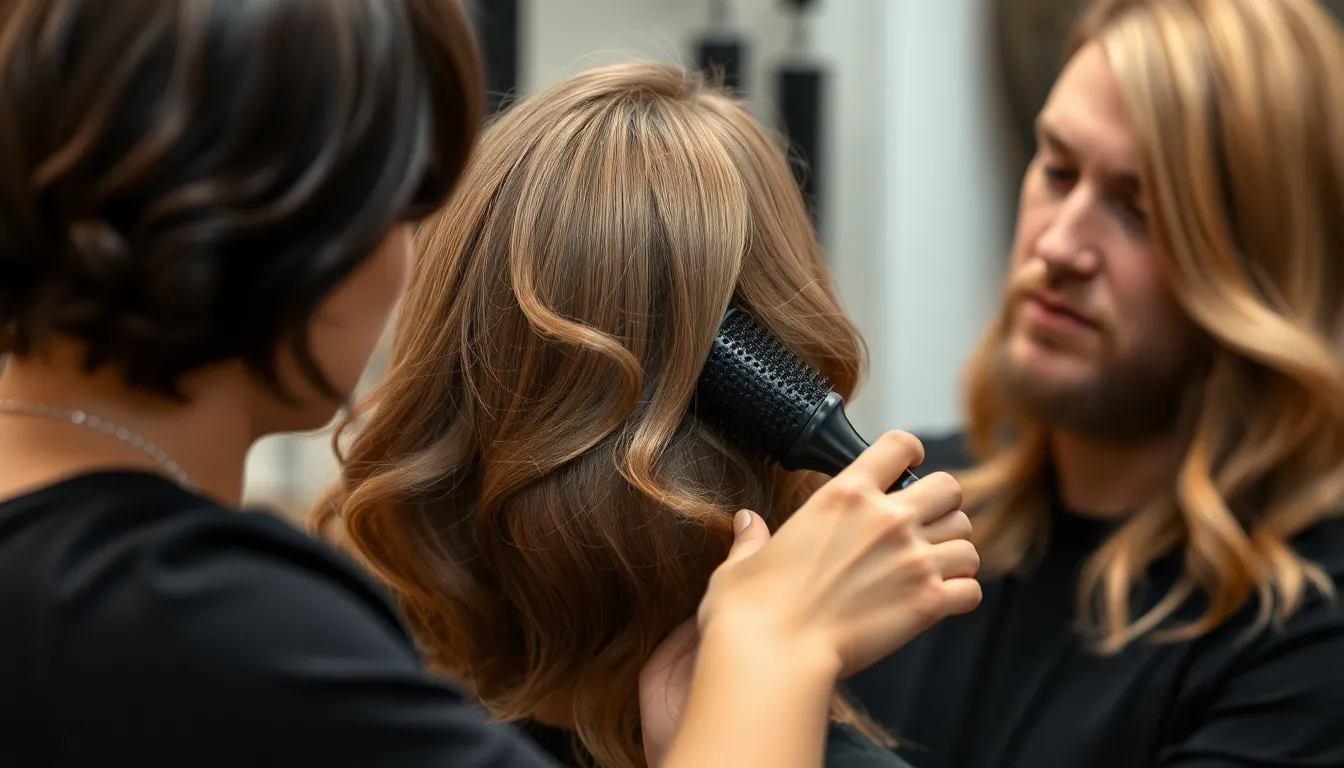
Even experienced stylists can fall into traps that compromise the elegant flow of feathered cuts. Learning to recognize these common pitfalls will help you achieve the polished, voluminous look that defines authentic feathered hair.
Over-Teasing and Product Buildup
Over-teasing creates stiff, unnatural volume that contradicts the soft movement essential to feathered styles. We recommend limiting teasing to the crown area only, using gentle upward strokes rather than aggressive back-combing techniques. Professional stylists suggest creating lift through proper blow drying methods instead of relying heavily on teasing.
Product buildup weighs down feathered layers and eliminates the natural bounce that makes this style so appealing. Using excessive amounts of mousse, hairspray, or texturizing cream results in heavy, sticky hair that won’t hold its signature outward flip. We’ve found that applying products in thin, even layers works better than concentrating them in exact areas.
Clarifying shampoos should be used weekly to remove accumulated styling products from feathered cuts. This prevents the dull, lifeless appearance that occurs when hair becomes overloaded with styling aids. Fresh, clean hair accepts volumizing products more effectively and maintains the airy texture that defines feathered hairstyles.
Incorrect Brushing Techniques
Wrong brush directions destroy the carefully crafted layers that create feathered hair’s distinctive shape. Brushing straight down flattens the volume and eliminates the outward movement that characterizes this style. We always recommend brushing in the direction of each layer’s intended flow, typically away from the face and slightly upward.
Excessive brushing breaks up the natural wave pattern and creates frizz that interferes with feathered hair’s smooth finish. Over-brushing also removes the strategic separation between layers that gives feathered cuts their dimensional appearance. Gentle strokes with a wide-tooth comb work better for maintaining the style’s integrity throughout the day.
Using inappropriate brush types can damage feathered layers and prevent proper styling. Paddle brushes flatten volume, while fine-tooth combs create static and breakage. We consistently achieve better results with round brushes that have natural boar bristles, which grip hair effectively while smoothing the cuticle for enhanced shine and movement.
Celebrity Inspiration for Modern Feathered Hair Looks
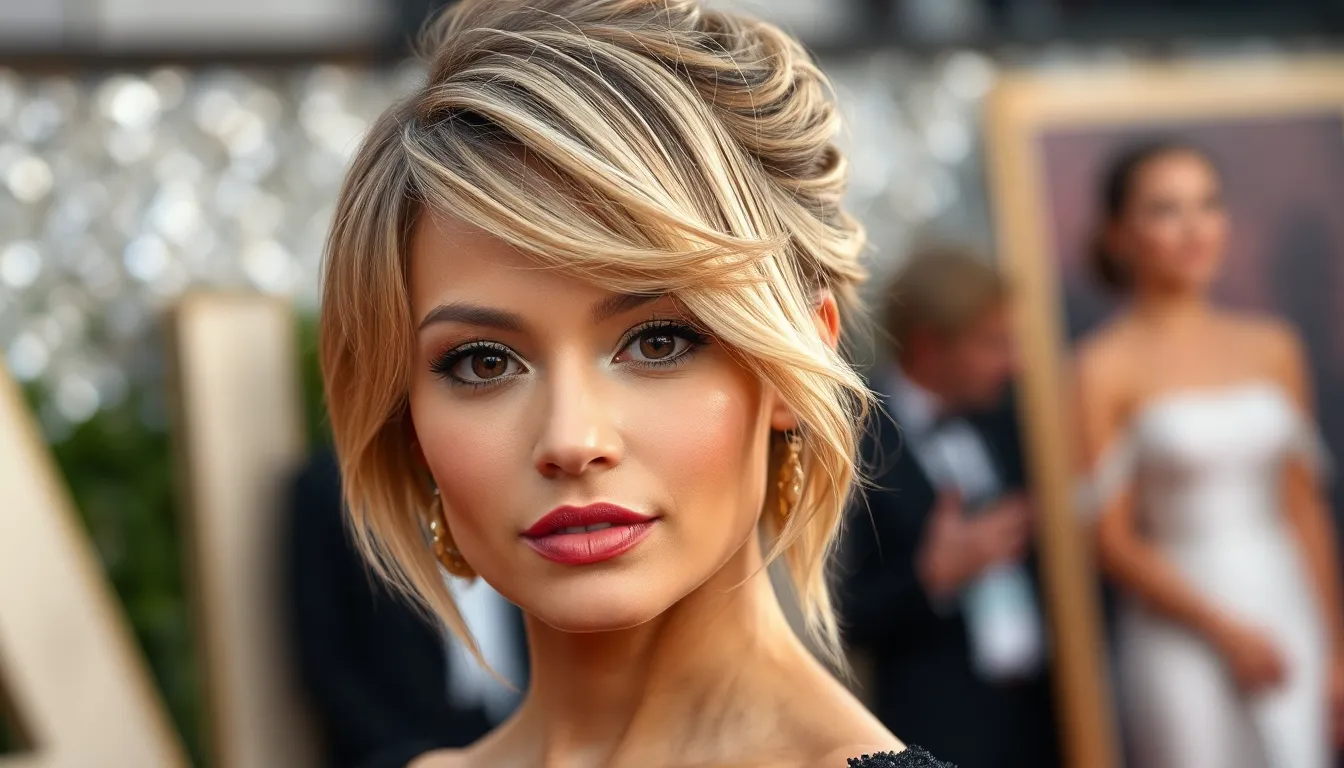
Today’s celebrities have breathed new life into feathered hair, transforming this classic style for contemporary audiences. We’re seeing A-list stars embrace updated versions that blend vintage glamour with modern sophistication.
Contemporary Stars Rocking the Trend
Margot Robbie leads the charge with her signature blonde feathered layers that perfectly frame her face during promotional tours. Her stylist creates volume through strategic cutting techniques that emphasize the natural movement of her shoulder-length hair. The actress demonstrates how feathered cuts can transition seamlessly from casual daywear to evening elegance.
Zendaya showcases versatile feathered styling across multiple hair textures and colors. Her red carpet appearances feature everything from subtle feathered layers to dramatic voluminous styles that highlight her natural curl pattern. Celebrity colorists often enhance her looks with dimensional highlights that accentuate the layered structure.
Jennifer Lawrence maintains her feathered bob as a signature look that complements her oval face shape. The Oscar winner’s stylist uses precision cutting to create layers that flip naturally away from her jawline. Her approach proves that shorter feathered styles can deliver maximum impact with minimal maintenance.
Blake Lively continues the feathered hair legacy with her long, cascading layers that create movement throughout her entire mane. Professional stylists achieve her signature look through extensive layering techniques that begin at her shoulders and extend to her ends. The actress frequently pairs her feathered style with subtle balayage coloring that adds depth and dimension.
Scarlett Johansson alternates between various feathered interpretations, from sleek shoulder-length cuts to textured pixie variations. Her styling team demonstrates how feathered techniques can adapt to different hair lengths while maintaining the essential volume and movement. These looks consistently feature professional blow-drying methods that enhance the natural bounce of her layers.
Red Carpet Feathered Hair Moments
The 2025 Met Gala featured multiple celebrities sporting updated feathered styles that dominated beauty headlines. Stylists created dramatic volume through backcombing techniques combined with flexible hold products that maintained shape throughout the evening. These looks incorporated modern elements like face-framing highlights and textured finishes that elevated classic feathered principles.
Golden Globe appearances consistently showcase feathered hair adaptations that photographers love for their photogenic qualities. Celebrity hairstylists use round brush techniques during styling sessions to achieve the perfect outward flip that catches light beautifully. The red carpet proves that feathered cuts photograph exceptionally well due to their natural movement and dimensional layering.
Fashion Week events have become showcases for innovative feathered hair interpretations that blend runway trends with wearable styling. Backstage teams use volumizing mousses and texturizing creams to create looks that maintain their shape under bright lights and camera flashes. These appearances demonstrate how feathered styles can complement haute couture while remaining accessible to everyday wear.
Award season styling repeatedly features feathered hair because of its timeless elegance and versatility across different face shapes. Professional stylists rely on heat protectant products and precision blow-drying to create looks that last through lengthy ceremonies. The consistent choice of feathered styles by top-tier celebrities reinforces the cut’s status as both classic and contemporary.
Conclusion
Feathered hair has proven its staying power by seamlessly transitioning from a 1970s icon to a modern-day favorite. We’ve seen how this versatile style continues to evolve while maintaining its signature volume and movement that flatters virtually every face shape.
The beauty of feathered hair lies in its adaptability – whether you’re working with fine strands or thick locks there’s a variation that’ll work for your unique features. With the right tools techniques and maintenance routine anyone can achieve this timeless look at home.
As celebrities continue to showcase fresh interpretations on red carpets and social media feathered hair remains relevant for today’s style-conscious individuals. It’s clear that this classic cut will keep inspiring new generations of hair enthusiasts for years to come.
Frequently Asked Questions
What is feathered hair and how is it different from regular layered cuts?
Feathered hair is characterized by strategically placed layers that flip away from the face, creating volume and movement. Unlike regular layered cuts, feathered styles focus on achieving fullness and natural bounce through precise cutting techniques that create a soft, flowing appearance. The defining feature is the signature outward flip of the layers, particularly around the face.
Which face shapes work best with feathered hairstyles?
Oval faces are most compatible with feathered styles, while round faces gain flattering definition through strategic layering. Square jawlines are softened with feathered cuts, and heart-shaped faces achieve balance with lower layer placements. Long face shapes benefit from horizontal volume that breaks up vertical lines, making feathered hair versatile for most face shapes.
What hair type is ideal for achieving feathered hair?
Medium to thick hair textures are ideal for feathered styles as they provide the necessary volume and hold. Fine hair can also work with proper layering techniques and volumizing products. Shoulder-length to long hair offers the most versatility, while wavy and naturally textured hair enhances the look with organic volume and movement.
How often should I trim my feathered hair to maintain the style?
Regular trims every 6-8 weeks are essential to preserve the precise layering of feathered hair. Face-framing pieces grow quickly and may need more frequent touch-ups. Consistent maintenance helps retain the style’s shape and prevents the layers from losing their definition, ensuring your feathered cut always looks fresh and polished.
What are the essential tools needed to style feathered hair at home?
Key tools include a round brush with natural boar bristles, a professional-grade blow dryer, and sectioning clips. Essential products are volumizing mousse, heat protectant spray, flexible hold hairspray, and texturizing cream. These tools and products work together to create the signature volume and outward flip characteristic of feathered styles.
Can feathered hair work for short hairstyles?
Yes, feathered techniques work beautifully on short styles like pixie cuts and asymmetrical bobs. Short feathered styles offer sophistication with minimal maintenance while still providing the characteristic volume and movement. The key is adapting the layering technique to shorter lengths while maintaining the signature outward flip around the face.
What are the most common mistakes to avoid when styling feathered hair?
Avoid over-teasing, which can damage hair and compromise the soft movement essential to feathered styles. Limit teasing to the crown area only. Prevent product buildup by using clarifying shampoos weekly, and avoid incorrect brushing techniques that can flatten volume. Use gentle strokes with wide-tooth combs and round brushes for optimal results.
How do I maintain feathered hair between salon visits?
Refresh layers daily with water or leave-in conditioner, apply volumizing mousse, and use a round brush during blow drying to maintain the signature flip. Focus on proper blow-drying techniques for lift and avoid over-styling. Regular communication with your stylist about hair texture changes and growth patterns ensures optimal maintenance of your feathered style.

